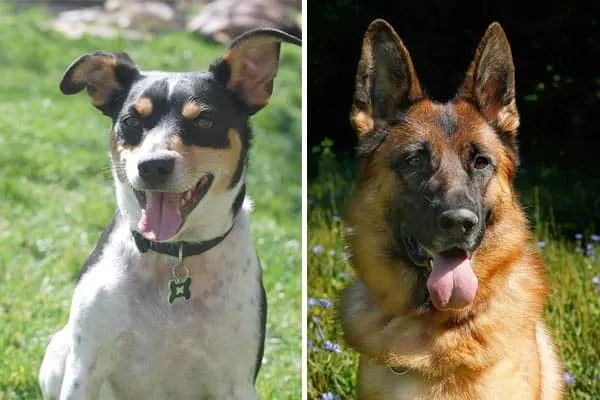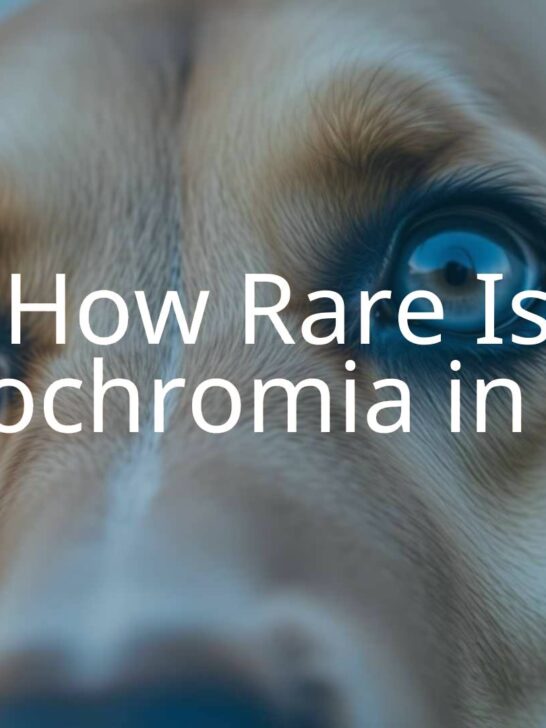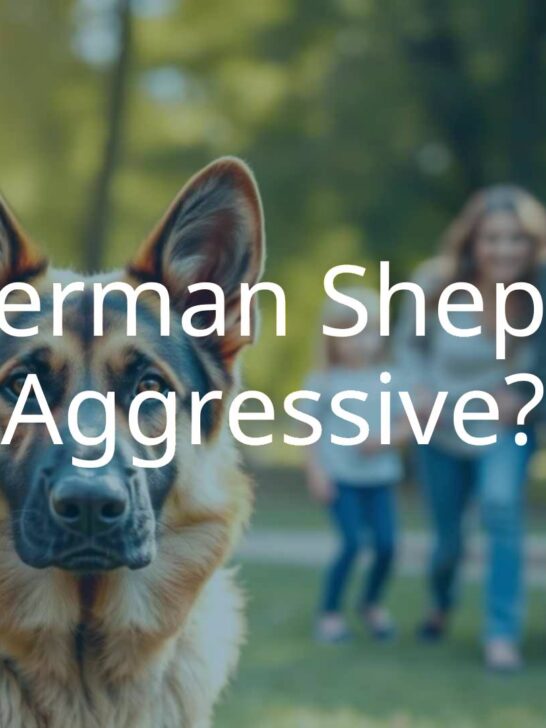Rat Terrier German Shepherd Mix: What Is the Best Info You Should Know About?
You probably do not lose much sleep wondering about the vast number of possible breeds you could mix with a German Shepherd. Chances are great that you would not even consider a few breeds as likely matches.
Judging by their rarity, the Rat Terrier German Shepherd mix is one of those hybrids not many people have thought to produce.
What can you know and say about the Rat Terrier German Shepherd Mix dog? Most of our definition of the cross is speculation from a deep knowledge of what each of the separate breeds brings to the table.
A blend would likely produce a very driven and active small to medium-sized dog who might have good hunting potential and would probably excel at agility and casual racing.

Half your dog is from a small but fierce hunter of vermin
The Rat Terrier’s background, designated purpose, and physical stature will contribute to your mixed dog’s temperament, exercise requirements, and appearance. Your pup will inherit qualities that affect training, grooming, and overall health.
The US developed the Rat Terrier from a British dog
The Rat Terrier developed from Fyce types that arrived in the US with British immigrant workers in the 1890s. Like sighthounds are a subgroup of the hound group, Fyce or Feist types are a subcategory of the terrier class.
- Jack Russell Terrier
- Rat Terrier
- Mountain Feists
- Parson Russell Terrier
- Fox Terrier
Feists readily distinguish themselves from other hunters like hounds as they utilize air and ground scent as well as sight to track their quarry, and they pursue it silently. They often specialize in rodents and hares but are fierce enough to effectively corner larger game like wild pigs.
Rat Terriers are treeing feists, meaning they often run animals like squirrels into trees and await their owners.
Feists and Rat Terriers from England originally involved crosses between English White Terriers, Smooth Fox Terriers, and Manchester Terriers as early as the 1700s.
They contributed fierceness and agility to the Bull and Terrier of the time even as they received additional speed from the Whippet and Italian Greyhound and pack social etiquette from the Beagle.
Although largely replaced by Bull and Terriers and later Pit Bull Terriers for rat baiting in England, Rat Terriers would prove to have an exceptional affinity for rat control in the US. Rat Terriers suffered a population decline with the arrival of rat and mouse baits and poisons in the 1950s.
The terriers would make a comeback in the 1990s, according to Rover.com. Their popularity was sealed when crosses with Chihuahuas and other Toy breeds increased their appeal as house pets, and their speed earned them a reputation in various competitions like agility and flyball.
Your Rat Terrier German Shepherd mix may pick up the following background characteristics from the Terrier side.
- Very alert and active, high-energy
- Fast and agile
- High prey drive – tendency to chase animals who run
- Intelligent
The Rat Terrier Shepherd could inherit several feist-like physical features
- Erect, button, or folded-tip ears
- Slender but muscular build – compact with relatively long legs; Beagle lines have shorter legs
- Short or bobtail
- Smooth coat with little or no underfur
Rat Terriers are about 10 to 18 inches tall and weigh from 10 to 25 pounds with more people seeking dogs under 13 inches at the shoulders. They were traditionally black and tan, but like others in the feist group, they are now often tricolor with large areas of white.
Rat terriers can also be calico, bicolor, fawn, chocolate, merle, or sable. Dilute colors like blue and Isabella or Pearl can appear with or without white markings and may also combine with merle.
Bicolor dogs are usually black and white or red and white. Sable is similar to the color in Collies where at first glance a Rat Terrier may appear solid brown until you notice the black-tipped hairs or varying tones of red.
German Shepherds contribute a background of drive and versatility
When you imagine a working GSD you most likely picture a large athletic and beautiful dog with a single-minded purpose and drive. It may shock you that German Shepherds did not always make the best working animals.
Max von Stephanitz chose a show dog named Hektor Linksrhein as the founding father of the German Shepherd breed.
Hektor, who under von Stephanitz became Horand, embodied the beauty of the herding dog type and could also work in the field.
However, many dogs of the Thuringian line were unfocused, unruly, difficult to train, and highly predatory and aggressive, according to Germanwatchdogs.com.
Von Stephanitz brought dogs from the Wurttemberg and Swabian regions of Germany to add stability, size, work ethic, and weather resistance to his sire lines.
German Shepherds developed an unparalleled ability to focus on work as well as versatility that made them useful during World War II when many other breeds were in severe decline.
Your German Shepherd mix will likely inherit at least a couple of the following attributes from his GSD parent.
- Intelligence, obedience, and trainability
- Focus and work drive
- Speed and power
- Courage, boldness, and self-assuredness
- Loyalty
German Shepherds have a distinct physical appearance
German Shepherds pass many of their signature physical attributes to their offspring.
- Upright ears
- Slight dome of the forehead
- Medium-long brushtail
- Slightly longer than tall
- Working lines have a slightly sloping back and show dogs much more exaggerated because of greater hindlimb angulation in America or steeper croup in West German lines
German Shepherds are 22 to 26 inches tall and weigh anywhere from 50 to 95 pounds. Show dogs have a higher expectation of a distinctly masculine and feminine appearance in the respective genders. Females are also typically smaller than males.
A GSD has a dense short to medium-length coat with a thick woolly lining underneath. Unlike the Rat Terrier, the German Shepherd does very well in winter cold and also insulates herself against heat and ultraviolet rays.
The Rat Terrier German Shepherd Mix is like combining a hybrid with a purebred dog
No one knows for sure when the first person decided to mix a Rat Terrier with a GSD or what the motivation may have been. Perhaps someone wanted a smaller German Shepherd or a more formidable hunting dog.
In any case, the mix probably initially occurred after 2000, well after the designer dog craze got underway in the 1980s.
What are the probable physical characteristics?
The Rat Terrier German Shepherd mix is particularly difficult to predict because the breed still has a large gene pool and highly variable traits from one generation to the next.
- Short hair with a sparse undercoat
- Upright or button ears
- Compact frame
- Medium-length tail
- Level back
- Rather large head for a Rat Terrier with a somewhat narrow muzzle.
Your mix will likely be 15 to 21 inches tall and weigh from 40 to 65 pounds. She will be black and tan, tan, blue, black, or liver and may have a significant amount of white markings or be a solid color.
What will temperament be like?
Your Rat Terrier German Shepherd Mix could have the disposition of either a German Shepherd or a Rat Terrier, but most will inherit some personality quirks from both sides.
- Extremely energetic
- Inquisitive
- Clever
- Focus – however, may not pay attention to what you want her to
- Not as obedient as GSD
- Not as prey-driven as Rat Terrier
- Tenacious
- Friendly with strangers but maybe overbearing – the chance of aggression towards strangers and other dogs
- A great watchdog, possible guarding potential
Your Rat Terrier German Shepherd Mix is likely to get along well with older children, especially those who are part of your household. Since your dog will be larger than a Rat Terrier, you should exercise caution as he is likely to be too rough for toddlers.
Conscientious socialization will help your dog get along with others of her kind. Although Shepherds can be dog aggressive against small canids or others of the same sex, Rat Terriers have a history of selection to cooperate in packs for hunting.
Rat Terriers have an overdeveloped predatory instinct and, coupled with the herding instinct of the GSD, can be dangerous for squirrels, rabbits, chipmunks, and even cats. Leashing Rat Terrier mixes is usually paramount to prevent unwanted chasing as stopping the behavior may be close to impossible.
What health issues should you recognize?
German Shepherds live about 10 to 12 years and Rat terriers 15 to 18. Expect your mix to have a lifespan of about 13 to 16 years and to be relatively healthy.
- Hip Dysplasia – both breeds
- Elbow Dysplasia – GSD
- Patellar luxation – Rat Terrier – kneecap slips
- Allergies – both
- Dental problems, bite malalignment – Rat Terrier
- Legg-Perthe’s – Toy Breeds – Femoral head degenerates
Grooming needs should be minimal
Your Rat Terrier German Shepherd will not likely have the dense coat of a purebred Shepherd’s that needs extensive brushing. You should brush your hybrid’s coat once or twice weekly to distribute skin oils and stimulate circulation.
Clip nails every four to six weeks and check ears at least once a week. Ear infections can occur secondary to allergies. Finally, since your mix is prone to an overbite, be sure to brush teeth and utilize chew toys as part of your biweekly routine.
Exercise needs will be substantial
Your Rat Terrier German Shepherd Mix will not be very large but will require lots of activity. Plan on spending 60 to 100 minutes running, training, and socialization of your dog. It is sometimes difficult to remember that both parent breeds are working dogs.
How much should you feed?
Your dog will require approximately 25 to 40 calories per pound of body weight every day. Your 40-pound Rat Terrier Shepherd who is moderately active will need about 1000 to 1600 calories of high-quality food daily. An approximate equivalent is two and a half to three cups of kibble per day split usually into two meals.
Varying food amounts according to activity level is important because obesity can exacerbate any orthopedic conditions such as hip dysplasia.
Side-By-Side Comparison Rat Terrier and German Shepherd Dog
You can note the size difference as well as the wide size gap. The Rat Terrier is a short-legged version, but note the characteristic is not the same as the phenomenon in Dachshunds, Bassett Hounds, and other similar breeds.
The Rat terrier looks like an Isabella, very dilute liver and tan, and the GSD is a classic black and tan. Note the difference in head shapes and the button, almost rose, ears on the Rat Terrier. You can try to visualize a mix of the two breeds.
The Rat Terrier may be a mix or not but illustrates the high variability in the Rat Terrier’s appearance.
Classic Rat Terrier
Commonly, the modern Rat Terrier is a tricolor dog with large upright ears and prominent ticking throughout the coat. Note the high activity level and also the dog’s similarity to another in the feisty group, the Jack Russell Terrier.




















